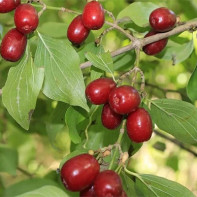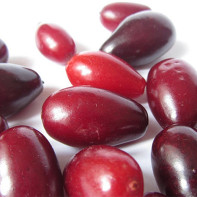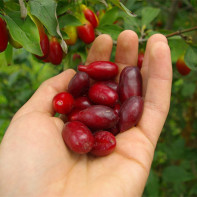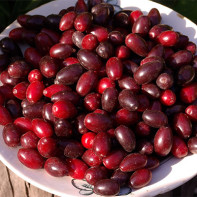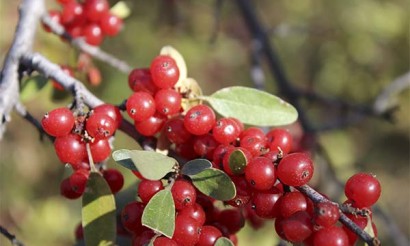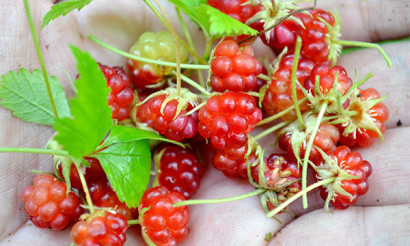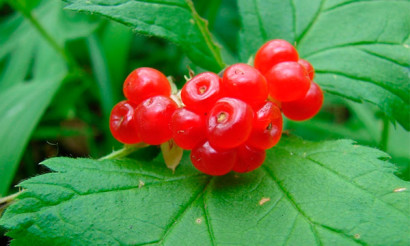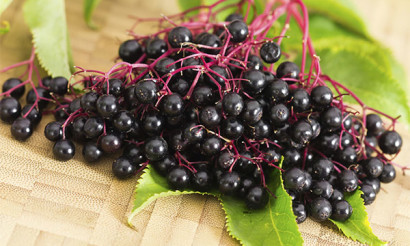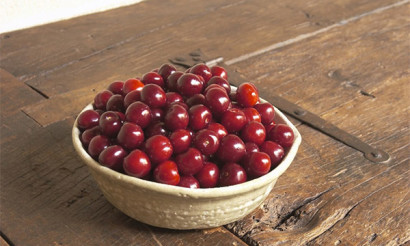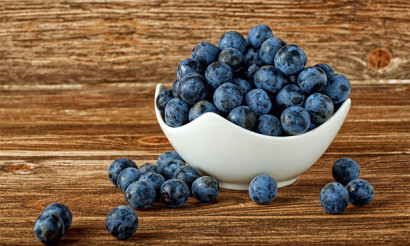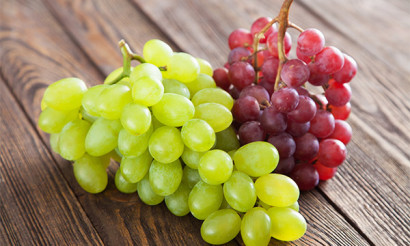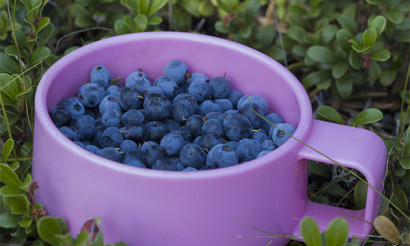Cornel (berry): useful properties and contraindications
The dogwood was called a small tree, which belongs to the number of long-livers. Its structure is very similar to that of various shrubs, and the maximum height of the plant does not exceed 5 meters. There are, however, documented cases of wild dogwood growing in natural conditions, reaching up to 8 meters in height. To date, botanists count about 50 species to this plant. The dogwood fruits have the appearance of scarlet berries with a very specific sour-tart flavor.
- What dogwoods look like and where they grow
- Types
- Composition and calories
- Useful properties of dogwoods
- General benefits
- For Women
- For Men
- In pregnancy
- For breastfeeding
- For children
- When losing weight
- Cornflower jam: benefits and harms
- What is the usefulness of dogwood leaves
- Usefulness of dogwood pips
- Usefulness of dogwood compote
- Health benefits of dogwood juice
- Dried dogwood / dried dogwood
- dogwood in medicine
- Diabetes mellitus
- For gastritis
- For Intestines
- For constipation
- For gout
- For the liver
- For hemorrhoids
- Cosmetic use
- For cleansing pores
- Fight wrinkles
- For oily skin
- For problem skin
- Universal
- Harm and Contraindications
- Harvesting and storage
- Can be frozen
- Can I dry it?
- What can be made of dogwood: Recipes
- Jam
- Jam
- Compote
- Wine
- Sauce
- Pastila
- Pickled dogwood
- Is it possible to eat dogwood with bones?
- Interesting facts about dogwood
What dogwood looks like and where it grows
The dogwood is one of the undeservedly avoided attention of gardeners, a plant that is able to grow in its place for 200 years. However, it begins to bear fruit quite late compared to other crops, for this requires a pause of 10 years. However, it bears fruit for two thirds of its life, going to rest only in the last decades.
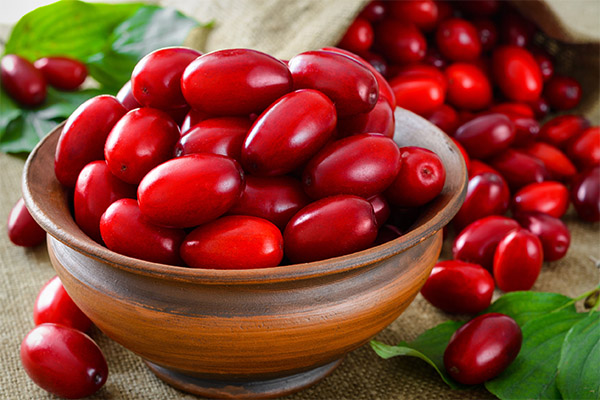
It does very well in winter, but in regions where the frost is above -30 °C, you should insulate it for the winter. The main advantage of this variety of fruit is the fact that the plant bears fruit every season. To improve its fruiting qualities, it needs systematic watering and inorganic fertilizers.
Regardless of species affiliation, whether it is a tree or bush variety, all plants actively surround themselves with new shoots that are yellow-green in color when young. As time passes, however, the young shoots are covered with a darker, cracked gray bark that later turns red.
The formed shrub can take on a rounded or pyramidal shape, and its leaves have elongated outlines with sharp ends. The upper part of the leaf has a glossy surface of bright green, while the lower part takes on a paler and matte color. At the time of flowering, the dogwood has an attractive ornamental outfit. Inflorescences take the form of lush umbrellas of yellow color and look very impressive on branches with not yet unfurled leaves, because the moment of flowering comes in early spring.
Under natural conditions, the perennial plant selects warm climatic conditions, so it is widely found in the mountainous forests of the Caucasus, Transcaucasia and Transcarpathia. In addition, a large number of wild dogwood can be found throughout the Crimean Peninsula. These areas provide the most optimal conditions for the growth and fruiting of culture.
The persistent character of the perennial allows it to grow also on the surface of rocks. Although such plants tend to acquire the appropriate structure. For example, dogwood, which grows on the territory of Armenia, has the form of a short-stemmed tree, located directly in the crevices.
On the territory of the Russian Federation, dogwood is often planted as an ornamental plant that makes up hedges. One of the reasons for the use of this crop is the ability to well tolerate winter frosts. All the nuances associated with the growing season, however, dictate certain rules when growing for quality and full-fledged fruits.
The thing is that flowering of culture comes early enough, and the period of ripening of fruits reaches the 200-day mark, which implies compliance with certain conditions. For this reason, in the middle belt of the Russian Federation prefer to use varieties of dogwood, located to early ripening. This feature avoids damage to inflorescences by late frosts, and the ripening period of the fruit comes before the autumn cold spells.
Species
The dogwood plants are a family consisting of four genera and more than 50 species. These crops prefer to inhabit both subtropical and temperate climates. Such zones are found in the Northern Hemisphere, up to the subarctic areas, in the southern as well as the tropical part of the African continent and in Malaysia. However, species capable of growing on the territory of the Russian Federation are brought to attention.
- Real. This is the name of the European variety, which is otherwise called turf. This plant has been known for a long time, since ancient times. The fruits of the variety have a dark red color and appear in early March, and have a sour-sweet taste and peculiar smell. The duration of life lasts from 150 to 200 years, and the size of a crop, beginning with the 15-year age, ranges from 40 to 80 kg. Breeding culture does not involve the use of special equipment.
- Medicinal. This plant is otherwise called Cornus officinalis, it is included in preparations used to treat bladder or kidney disease. In addition, it is possible to meet Korean gatherings, whose action is aimed at healing impotence. In addition, on the territory of East Asian countries this variety of dogwood is used as an antidiabetic. Its main advantages are its resistance not only to dry areas, but also its ability to withstand winter frosts. Almost any soil is suitable for the growth of such a plant.
- Swedish. This representative, which belongs to the family of dogwood, is classified as a group of herbaceous plants. Another name referring to this culture is alpine. Its homeland is the mountains of the European continent, where this dogwood is the most common. The plant has stems that are creeping on the soil and are characterized by underground rhizoids. The growth capacity of such shoots is 2 cm per year. It requires high humidity conditions. Its preference stops at peaty soils, characterized by high humidity, as well as a lot of acidity. As a rule, the culture is a groundcover plant, located near acidophilic shrubs.
- Canada dogwood. This species of dogwood is capable of forming thickets with dense density. It blooms in small inflorescences with small flowers that are yellow-green in color. They consist of a white wrapper with four petals. The fruits of the plant are bright red in color and are collected in bunches. Such dogwood does not need bright sunlight and feels great even in full shade, creating a dense ground cover.
- Flowering. This species of dogwood represents one of the most attractive varieties of American trees. It has the appearance of a tree, reaching a height of 5 meters, with an oval leaf shape and bright inflorescences of white-green color. The flowering period lasts from April to May. The fruits of the crop are collected in bunches that have a red-orange coloration. This variety is actively used in landscaping processes, given the ability of the plant to form attractive trees with many fruits of a specific shape. Flowering dogwood is also popular in Central Asia, where it has been known for over 200 years. The plant is characterized by excellent winter-hardiness and feels excellent even in the conditions of northern regions.
- Nutalla. This variety is otherwise called the mountain dogwood. It is distinguished by its bright inflorescences, composed of many flowers, which are connected by common petals of 6 pieces, colored pale pink or white. The bright fruit is elliptical in shape, measuring 6 mm across and 10 mm long. The flowering period occurs in May. The ideal natural environment is considered the northwestern part of the American continent. This plant is excellent in an enclosed environment and is suitable for planting in wooden boxes.
- Headstock. This variety also has another name, otherwise it is called a strawberry tree. Its fruits are traditionally formed into clusters and are bright orange in color, and its inflorescences are formed of about 30 flowers. It is native to central China and can also be found in the Himalayas.
- Japanese. The second name for this dogwood is the Japanese word for kouza. Its inflorescences also contain brackets (pointed petals which wrap around the inflorescence). Over time, mature plants take on a delicate pink hue that adds to the decorative qualities of the species. The flowering period of this variety comes in June and lasts a month and a half.
Composition and calories
Since ancient times, dogwood has been used as a therapeutic and prophylactic agent. Among other things, there are mentions that in the Caucasus baked special cakes of dogwood fruits, which were used to combat the appearance of scurvy in the famine years. This fact is proved by a high concentration of vitamin C in the ripe fruit, which surpasses even the black currant berries.
In 100 g of berries contains the following elements:
- water - 85 g;
- vitamins (P, C, A);
- 2 g of organic acids (succinic, citric, gallic, apple, tartaric);
- ash - 0.8 g;
- minerals (magnesium, iron, sulfur, sodium, calcium, potassium, phosphorus, zinc), etc;
- dietary fiber - 1.5 g;
- monosaccharides and disaccharides - 9 g.
The energy value of dogwood berries per 100 grams of product are 1 g of protein and 9.7 g of carbohydrates. The low caloric value is due to 43 kcal per 100 grams.
Useful properties of dogwood
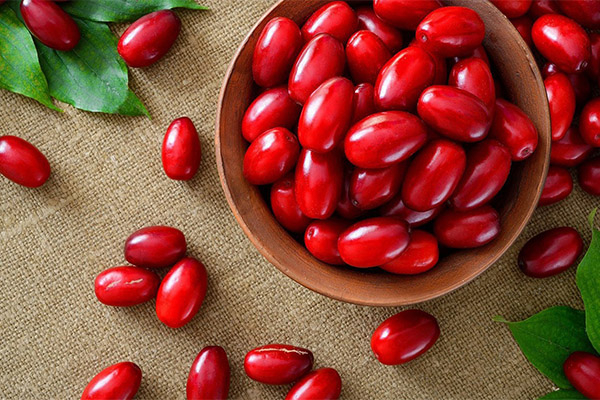
General benefits
The dogwood berries have many health benefits for the human body. They are used both to increase appetite and to stabilize metabolism. In addition, they are recommended for use in the prevention and treatment of such a common disease as diabetes. Dogwood has the ability not to increase the concentration of glucose in the blood, but significantly increases the enzymatic activity in the pancreas, which improves the digestibility of food.
For women
Useful elements contained in the composition of dogwood can provide invaluable benefits for the female body. Thanks to the richness of the vitamin composition and high concentration of useful minerals, the systematic consumption of dogwood fruits can improve the overall condition of the skin. In addition, fresh berries are a low-calorie product, which is of great importance in the selection of diets. In addition, they help to increase and stabilize the metabolism. Also, dogwood fruits are actively used to rid the body of toxins and all kinds of toxins.
For men
Often a man's lifestyle involves heavy physical labor, which affects the general fatigue of the body and reduces the resistance to various disorders. The high content in the composition of dogwood useful trace elements can replenish the vital composition, and a rich vitamin base will reduce fatigue, improve metabolism and activate the immune system. In addition, dogwood fruits help improve sexual function, which increases sexual desire and increases potency.
When pregnant
Not only does dogwood have no contraindications for pregnant women, but it can also be recommended as a means of preventing the threat of miscarriage. It is recommended for use throughout the entire period of pregnancy (as an alternative to some medications). It is an effective remedy that stimulates the proper development of the fetus and increases the resistance of the body of the future mother. The composition of dogwood includes a large number of useful trace elements, which are necessary for both the mother and the developing child.
When breastfeeding
For breastfeeding mothers, there are no contraindications that would not allow to include this product in the diet. Cornelian fruits help to normalize the activity of the gastrointestinal tract and have a positive effect on the mother's body. However, you should carefully monitor the infant's stools for constipation, in which case the use of dogwood is restricted or temporarily suspended. For this reason, it is advised to include in your diet, not fresh berries, and morsels or compotes made from juice.
For children
Fully consume dogwood is allowed to children after the age of 3 years, when the stomach has acquired the ability to digest the complex components. Before this age, the consumption of dogwood should be in strict limits for each stage of development. After all, an overabundance of dogwood in children's bodies can cause such disorders as stomach heaviness, constipation, stomach cramps and general discomfort. In addition, berries can provoke nausea, accompanied by vomiting, poisoning and food allergies.
When losing weight
Cornelberries have the ability to have a choleretic, as well as diuretic effect. They have an effect on stabilizing the metabolism in the body and help in reducing blood sugar. Such qualities are of considerable value when using a diet for weight loss. In addition, dogwood has the ability to reduce fever and relieve inflammation, stabilize blood pressure and cure migraines, actively resist skin diseases.
dogwood jam: benefits and harms
If you cook dogwood jam properly, it will retain a high content of vitamins in its composition. This will have a positive effect in the treatment and prevention of many diseases. For example, the high content in the composition of jam of vitamin C and some other components that have antibacterial properties, makes it easy to eliminate the symptoms of a number of colds. For this purpose, jam is recommended to use with tea and other hot drinks, such as warm milk or heated decoctions of herbs, which will significantly speed up the recovery process.
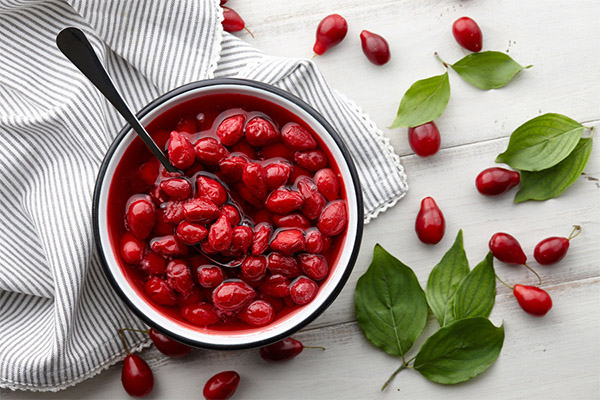
Cornelberries, including jam, have no harmful qualities that have a negative impact on the human body. However, the delicacy has a number of contraindications for some diseases, which makes it necessary to reduce or eliminate the consumption of the product completely. Thus, dogwood jam is not recommended for diabetics because of the sugar content in the composition. In addition, such a delicacy is also contraindicated to persons with hyperacidity or chronic constipation, because it can cause exacerbations.
What are the usefulness of dogwood leaves
In the content of dogwood leaves there are about 14% of tannides. Infusions created from such raw materials have an astringent effect and are used as a choleretic, as well as a diuretic. It's enough to brew 1 tbsp of dry, pounded leaves with a glass of boiling water to get an effective remedy that can cure the ailments. Take such a tincture is advised to take 3 times a day, one-fourth of a cup.
Are cornel seeds useful?
Pips of dogwood, as a rule, do not throw away, they are collected for use as a means to treat a number of diseases. They can exhibit the following beneficial effects:
- anti-inflammatory;
- astringent;
- regenerative;
- antibacterial;
- healing.
The seeds contain a substance that helps to narrow the blood vessels, which is of great importance in the formation of bleeding. In addition they have tonic qualities that allow to stabilize the basic functions of the body. This increases the resistance to colds, reduces chronic fatigue, and activates the immune system.
The benefits of dogwood compote
In some cases, fresh dogwood berries are not recommended to use, for example, when breastfeeding or increased acidity of gastric juice. In this case, you can replenish the stock of vitamins and minerals in the body with the help of compote, boiled from the fruit. When properly made, the drink retains a high content of vitamin groups. This is good for a weakened body.
The benefits of dogwood juice
Juice of dogwood is able to provide therapeutic properties for gastrointestinal diseases, as well as bleeding and lesions of the oral cavity. In addition, dogwood juice is an excellent tonic that can invigorate the body for a long time.
Also dogwood juice is used for the prevention of diabetes as a means of reducing the concentration of glucose in the blood. The high content of vitamins in the juice allows you to replenish the vitamin balance every day. It is used in gastric disorders as a means of stimulating the enzymatic function of the pancreas.
The benefits of dried (dried) dogwood
When drying, berries are not subjected to heat treatment, they are harvested at natural temperatures, which allows the fruit to preserve not only the energy components, but also the vitamin value.
It is important to note the increased energy value of the product, which excludes it from the list of dietary products.
Dried dogwood is able to almost fully preserve the high concentration of vitamins, which the human body needs in winter. He serves as an excellent source for restoring the daily balance of necessary microelements.
Cornelia in medicine
This plant has multiple medicinal abilities that can relieve people from the development of various diseases. These include colds and viral infections, pockets of inflammation and dysentery, gastrointestinal malfunctions and gallbladder disorders. Healing plant will not only be an excellent preventive tool for these ailments, but also will actively assist in their treatment.
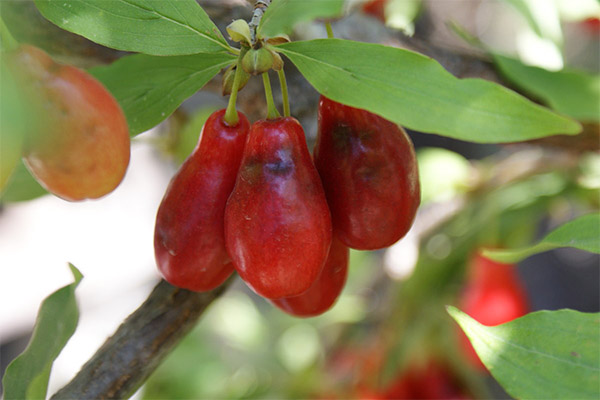
Diabetes mellitus
This is a fairly common disease, in which patients are forced to adhere to a strict diet. In this regard, people suffering from this ailment are not advised to consume fresh fruits. The best remedy for them is dogwood juice, which can stimulate the activity of the pancreas and the digestive tract in general, and also help to lower the concentration of glucose in the blood.
In such cases, it is recommended to take 100 ml of juice immediately before a meal. Provided that the body reacts normally, the dosage can be increased to 200 ml. However, after 10 days of taking the product, it is recommended to take a break for a few days.
Important: The glycemic index of dogwood is 25 units.
With gastritis
People with gastritis should consume dogwood, especially in the form of fresh fruit, with great caution. This is due to the fact that dogwood contains a high concentration of various acids that can cause exacerbations.
For this reason, patients suffering from gastritis, to replenish useful micronutrients, it is recommended to consume derivatives of the fruit in the form of morses or compote. In these drinks, the concentration of acidic components is significantly reduced, and the vitamin base retains significant potential.
For the intestines
The presence of tannins in the composition of dogwood helps to create an astringent effect, thanks to which the fruit is used against various intestinal disorders. Tannins also increase appetite and stabilize metabolism.
Made from berries compote can not only replenish the body with useful trace elements, but also used as a tonic drink, the equivalent of tea or coffee.
For constipation
The astringent effect, which is provided by the composition of dogwood fruits, due to the presence in it of tannins, is contraindicated for people suffering from constipation. In such situations, fresh dogwood berries are recommended to use with great restrictions, so as not to cause an aggravation. Still, people who suffer from these disorders, it is recommended to use dogwood morsels or compote.
With gout
Dogwood provides an uninterrupted exit from the body of both uric acid and oxalic acid, which makes it very useful for people suffering from gout, as well as metabolic disorders. In addition, dogwood berries have healing powers for inflammation of the skin or eczema. In this case, the medicinal properties have not only the fruit of the plant, but also the leaves and bark. Decoction of such raw materials is recommended for patients with rheumatism or polyarthritis.
For the liver
The fruits of dogwood have excellent hepatoprotective effect, which allows to activate the function of the liver, weakened by inflammatory processes or toxic hepatitis. It is actively used as a preventive agent, preventing liver disease. The ability to have an antibacterial effect allows you to actively resist various inflammations, and the presence of pectins promotes the release of toxic compounds from the body.
Hemorrhoids
An effective remedy for the healing of this ailment are dogwood fruits. The easiest way to use them is to consume 15 pieces whole throughout the day, with fresh fruit can be replaced by jam. Alternatively, you can grind the pips into powder and take a tablespoon three times a day.
Cosmetic applications
In cosmetology, dogwood is considered a very promising tool, which creates the preconditions for its active use. The fruits of the plant serve as an excellent basis for creating nourishing masks or scrubs. In addition, some therapeutic masks use dogwood bark to counteract inflammation.
There are many recipes that allow you to make practical masks at home. The pulp of the fruit serves as the basis for creating vitamin or moisturizing masks for facial skin, as well as improving the condition of the hair. Cornel seeds are used as the basis for making scrubs, used both for the face and for the body.
Masks and moisturizing creams made with dogwood extract serve as excellent skin toners as well as moisturizers. These products are used to clean pores, remove oily shine and blackheads, and smooth out wrinkles. Decoction of dogwood is used to rinse hair and as a means to get rid of dandruff and improve tissue structure.
For cleansing pores
Decoction of chamomile in combination with dogwood pulp will serve as an excellent means to permanently clean the pores of the face. To make, according to the recipe, it is necessary to prepare 200 g of dogwood, 50 ml of chamomile broth and 1 medium-sized potato. Prepare the mask in the following order: first, from the washed dogwood take out the seeds and grind it with a blender. Then grate peeled potatoes on a fine grater, add them to the dogwood and mix well. Finally, chamomile decoction is added and finished with a blender.
The use of the resulting mask is quite simple. First, before applying the composition thoroughly clean the skin, and then apply the mask. On the face, the applied composition is kept for 20 minutes, and then washed off with cool water.
Against wrinkles
Use a very simple, but quite effective mask. According to the recipe, you must prepare 30 grams of dogwood pulp, 30 g of mashed banana, 10 g of ground oatmeal flakes and 10 grams of starch. To prepare the mask, all the prepared components combine, knead well and leave for 5 minutes to infuse. At the end of the time the mixture is mixed again and the mask is applied to the face for 30 minutes. At the end of the mask is washed off with cool water. The procedure may be performed daily, and it is recommended to do it in the morning and evening. If this condition is observed, the first results of the rejuvenating effect can be noted on the 5th day.
If the skin of the face is characterized by dryness, then the starch with ground flakes substitute 1 tbsp of olive oil. Although in the original (if possible) it is better to use grape, almond, rosehip or peach seed esters. Due to the high content of antioxidants and other trace elements, the mask accelerates the process of cell regeneration.
For oily skin
In the preparation of a mask for oily facial skin, use the following components: 2 tbsp of crushed dogwood pulp, protein from a chicken egg and ½ tsp of starch. To prepare the composition, whip the egg white well, mix with the berry pulp, add the starch and mix the composition again. Ready mask applied to the face for 30 minutes, then rinse with cool water. The composition of this mask has the ability to remove greasy plaque and purify pores. This narrows the pores on the face, avoiding further filling with impurities, and the cells receive a fair portion of useful microelements.
For problem skin
To make such a mask at home, you will need 2 tbsp. puree of fresh dogwood berries, 2 tbsp. mineral water and 3 drops of lavender oil. Pour the dogwood puree with mineral water and allow to stand for 10 minutes, then add the lavender oil and whip until foamy. Before applying the mask the face is thoroughly cleaned and steamed, then the composition is applied in a thick layer. Exposure time is 20 minutes, and then the composition is washed off the skin with cool water.
Such a mask has the ability not only to clear the skin, while removing toxic compounds from the pores, but also to eliminate inflammation.
Universal
To prepare the mask, prepare 1 tbsp. crushed seedless dogwood berries, 1 tbsp. white clay and 1 tbsp. linseed oil. To obtain the composition all the ingredients are combined and well kneaded to a paste-like state. The ready mass is applied to the prepared face, rubbing with massaging movements, and incubated for 15 minutes. At the end of the time the composition is washed away with warm water. Such a mask is also suitable for hair care, but in this case, the total amount of composition is increased according to the proportion.
It is important to know that this composition has a short shelf life, so it is recommended to use it immediately after making.
Harms and contraindications
The high content of various acids can cause a relapse in people with hyperacidity, for this reason they need to consume dogwood with caution.
People suffering from chronic constipation, fresh berries and juice from them are contraindicated, in this case it is worth limiting the use of compote or kissel.
In addition, dogwood has strong tonic qualities, which makes it not recommended for intake at night. Small children, the elderly, pregnant women and nursing mothers are advised to consume dogwood with great caution. Excessive consumption can lead not only to overstimulation, but also to insomnia.
Harvesting and storage
Harvesting begins in August and continues through September as they ripen. If dogwood is grown in orchards under equal light conditions, all fruits ripen at the same time. For trees in natural conditions, where the degree of light can vary, the ripening time can vary in a period of up to 10 days. In addition, other reasons can affect the quality of the fruit and the ripening time, such as the abundance of irrigation, on which the succulence directly depends.
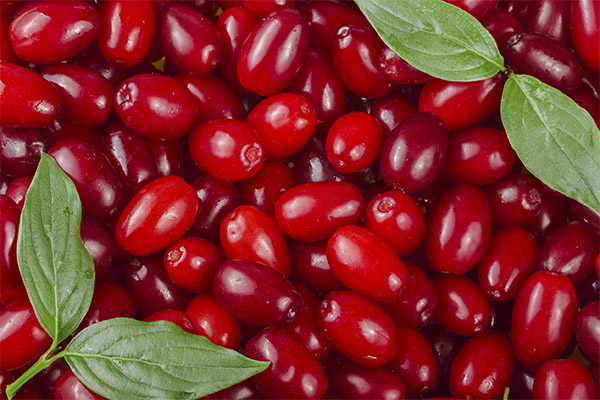
It is not recommended to transport dogwoods that have reached full maturity. If the ripened crop is to be transported over long distances in the future, it should be harvested at the phase of technical maturity. In other words, fully mature fruits should reach the halfway stage of color from the ripe state. At the same time, technically ripe fruits should be firm. They can only be harvested fully by hand.
At the same time, fully ripe fruits are allowed to collect by shaking, because at this time they are easily detached from the stalks. If harvesting is done for processing purposes, it is acceptable to use fruits that have fallen from the tree. On the other hand, overdue harvesting time is not recommended for a number of reasons. First, ripe fruits are not able to linger on the tree and quickly fall off. Secondly, there are many hunters among birds for ripe fruits, which are able to spoil the harvest. Third, overripe fruits are very likely to be lost to fruit rot.
Harvested crops are recommended to immediately process or send for long-term storage, because in the normal state it can last only 10 to 12 days at a temperature no higher than 5 degrees.
For long term storage it is better to choose fruits that have been picked with the stalk. The berries should be kept in the freezer at a temperature not higher than -18°C for 1 year.
Can I freeze them
Cornelberries are among those berries that do not lose their quality if frozen. The thing is that freezing doesn't have such negative consequences as heat treatment, allowing fruits to preserve most of their vitamin potential. Plus, freezing improves the taste of dogwood, so in this sense it will only benefit.
Before this, berries must go through a certain preparatory process, without which it is possible to lose a significant part of the harvest. One of the main conditions that must be strictly observed when deciding to send fruits for freezing is the selection and preparation of berries suitable for the procedure. Here it is important to know that only fully ripe berries should be frozen. If they have not reached maturity, they should be decomposed in a single layer and wait until they are fully ripe, only then can you start freezing. Determining the ripeness of dogwood fruits is quite simple by the color and taste. Ripe dogwood takes on a bright red color and has a characteristic tart, and at the same time sour-sweet taste.
Another important condition is that you should not freeze damaged fruits. They are capable of acquiring negative flavor shades, and it is quite difficult to distinguish them in the unfrozen form. As a result, you can lose the valuable flavor of the entire frozen batch.
Can dogwood be dried
The most preferred option for harvesting dogwood for the winter is its drying, because in this way you can preserve the useful qualities almost to the full. The easiest way to procure the fruit by this method is to dry it in the open space. However, it is much more convenient to use a special dryer. It will not only speed up the drying process, but also save the fruit natural color.
Fruits of both wild and cultivated dogwood are equally suitable for drying. Before drying, the fruits should be thoroughly sorted, first of all separating out all the damaged ones. Next, select the unripe berries and put them aside until they reach maturity. Only fully ripe and undamaged berries can make a good harvest for the winter. Before drying, they are washed well in cold water with a little vinegar, separating at the same time all the stalks. Dry dogwoods without removing the pips.
What can be made of dogwood: Recipes
dogwood has excellent qualities in the fresh form, but also winter preparations from its fruits are no less attractive. Recipes differ in considerable variety, but often dogwood is used in combinations with other fruits that have less acidity.
Not only can dogwood be dried and pickled, it can even be salted. The juices boiled together with sugar make an excellent sauce that goes well with meat. Lavash is made of mashed flesh according to a special recipe, using wooden spoons. Such dishes are very prized in the Middle East.
Jam
To cook dogwood jam according to the classic recipe, you need to prepare 2.3 kg of fruit, 2.6 kg of sugar and 0.8 l of water. First of all, dogwood should be prepared, to do this, it is washed and the stalks are removed. It should be borne in mind that for jam any fruits are suitable (whether they are hard or overripe - it makes no difference). In this case, if they are soft, you need to handle them carefully, if they are hard - you should make a few punctures to get out the juice. For jam, the pips are not removed from the dogwood.
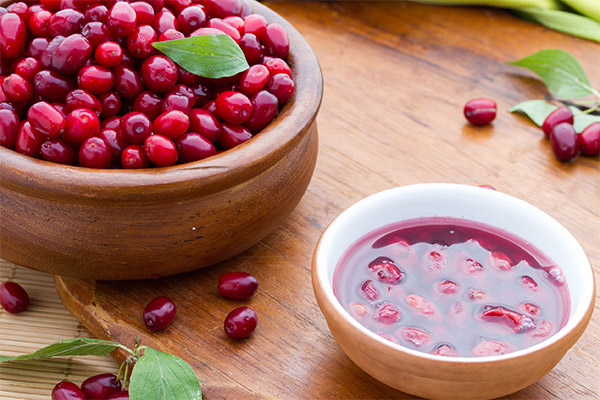
Next, make a syrup, for this purpose, the available sugar is dissolved in the prepared water and put on the fire until it boils. Prepared berries poured into the boiling syrup and removed from the stove at once, cover and let stand for 4 hours, stirring from time to time.
Jam
To prepare the jam you need to prepare the following components: 1 kg of dogwood, 0.3 liters of water, 0.4 kg of sugar. First of all, the fruits are washed, then put in a pot and pour the prepared water. Then turn on the fire and boil for 10 minutes with the lid closed. After that, boiled berries are rubbed through a fine sieve. Then add the prepared sugar to the mashed potatoes, mix them slightly and put on a low heat for 25 minutes, stirring regularly. At the end of the time the hot jam is closed in a sterile jar.
Compote
To prepare the compote, you need to prepare 0.8 kg of dogwood, 2.8 liters of water and 1.5 cups of sugar. Prepared berries are washed under running water. Next, the water is poured into a saucepan and brought to a boil. Meanwhile, washed dogwoods are put in a 3-liter sterilized jar and covered with sugar. When the water in the pot boils well, it is poured into a jar with dogwood, corked and placed for slow cooling under a blanket lid down.
Wine
For this recipe you need to take 2.5 kg of dogwood, 4 liters of water, 1.3 kg of sugar and 1 tsp of yeast. The berries are placed in an enamel saucepan and kneaded well. Then boil 1 liter of water and dissolve 200 grams of sugar, after which the hot syrup is poured dogwood, knead and wait until it cools. After cooling in the resulting composition add yeast, cover the pot with a cloth and put in a dark place for two days.
At the end of the time, strain out all the liquid from the dogwood through gauze. Boil the remaining water and dissolve the remaining sugar in it. After complete cooling of the syrup is combined with the liquid, decanted from the dogwood, poured into a glass container and put a water seal. At the end of the fermentation process, the wine is decanted and bottled.
The sauce .
To prepare the sauce, prepare 0.5 kg of dogwood, 1 bunch of herbs (optional), 2 paprika pods, 1 tsp. hopli-uneli, 5 cloves of garlic, 2 tsp. sugar and 1 tbsp. olive oil. Peeled dogwoods are washed with cold water, poured into a saucepan and poured with water to the level of the berries. Then bring the composition to a boil over a very low heat and boil for 15 minutes.
Meanwhile, finely chop herbs, as well as peeled garlic and peppers. After that, the prepared components are mixed and salted. After boiling, dogwood is removed from the pan, separated from the seeds and finely chopped. At the last stage, cornel puree poured back into the pan, combined with spicy dressing and cook for 10 minutes.
Pastila
For the recipe you will need 0.5 kg of dogwood, 0.3 kg of walnuts and a glass of honey. Over-ripe dogwood fruits are washed and separated from the seeds, and the remaining pulp is rubbed through a sieve. The resulting puree is transferred to a saucepan and stew over very low heat for 15 minutes to evaporate liquid. Then a baking tray covered with parchment paper is smeared with butter. The composition obtained after evaporation, spread on a prepared surface with a layer of about 1 cm and dry in an oven for 2 hours, set at 150°C.
Meanwhile, pound the prepared nuts, and when the marshmallow has dried, sprinkle them on top. On top of the nuts smeared with honey. At the end, the marshmallow is rolled up and the edges are trimmed.
Pickled dogwood
To prepare this treat you need to prepare 1.5 kg of dogwood, 2.5 cups of water, 1.5 tablespoons of salt, 20 cloves, 3 bay leaves, 1 tbsp. sugar and 100 ml. vinegar. In the prepared water add vinegar, salt and sugar, stir and boil the marinade. Meanwhile, pierce the washed dogwood with a wooden toothpick. The berries are placed in a sterilized 3-liter jar along with the prepared spices, pour the cooled marinade. Send for 12 days in the refrigerator, then close.
Can dogwood with bones be eaten?
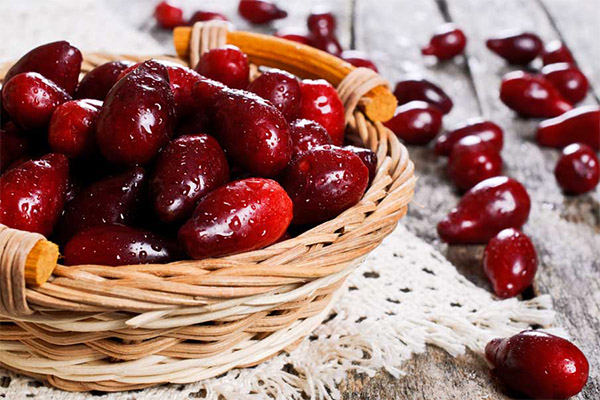
Strange as it may sound, but it is not only possible, but also necessary to swallow dogwood bones because of their high content of useful elements (no more than 10-15 pieces per day). At the same time, dogwood bones are able to dissolve in the stomach, so it does not matter at all whether they got there as a whole or in a ground state. The dogwood seed contains a high concentration of fatty vegetable oils, which are required in the human body.
Interesting facts about dogwood
- Dogwood is known in Christianity, because, according to legend, the cross prepared for the crucifixion of Christ was made of it. At that time it was the largest tree in Jerusalem. But then it became more like a shrub.
- In the lore of ancient Rome, the founder of the great city, Romulus, delineated the original boundaries with a spear that was made of dogwood. After the work was done, he stuck the spear in the ground and it turned into a dogwood tree the next morning.
«Important: All information on this site is provided for informational purposes only. for informational purposes only. Please consult with your health care professional before using any of the recommendations. specialist before using any of the recommendations. Neither the editors nor the authors shall be liable for any possible harm caused by materials."


